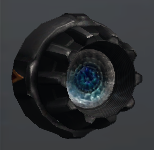Difference between revisions of "Jet engine"
m (+cat;) |
m (Jet engine thrust depends on speed, not altitude, see velocityCurve in part.cfg's. Isp depends on altitude.) |
||
| Line 17: | Line 17: | ||
* Cannot be used outside of an atmosphere that contains oxygen. In current version, it means they only function on [[Kerbin]] and [[Laythe]]. | * Cannot be used outside of an atmosphere that contains oxygen. In current version, it means they only function on [[Kerbin]] and [[Laythe]]. | ||
| − | * Thrust output changes depending on | + | * Thrust output changes depending on speed |
* Engine requires time to spool up to maximum thrust potential | * Engine requires time to spool up to maximum thrust potential | ||
Revision as of 09:27, 25 August 2013
A jet engine is an air-breathing engine which uses onboard fuel and combusts it with the oxygen drawn from the atmosphere. Due to the lower air pressure at higher altitudes its thrust output varies accordingly.
Usage
Unlike rocket engines, a jet draws oxygen from the atmosphere rather than taking it from an on-board tank. This is represented in-game by a much lower rate of fuel consumption. Depending on the aircraft, jet engines can produce thrust at altitudes greater than 20km. Jet engines do not perform in the same manner as rocket engines. Since Jet engines rely on a turbine to compress fuel and atmosphere together in order to produce thrust, it takes time to change speed. Also if the throttle or air flow are too low the engine will stall. By contrast, rocket engines give instant response to control input.
As of version 0.18 jet engines require air to run, provided by air intakes.
Advantages
- Provides excellent fuel efficiency within an atmosphere
- All current jet engines provide thrust vectoring for greater maneuverability
- Excellent power to weight ratio
Disadvantages
- Cannot be used outside of an atmosphere that contains oxygen. In current version, it means they only function on Kerbin and Laythe.
- Thrust output changes depending on speed
- Engine requires time to spool up to maximum thrust potential
Available jet engines
| Image | Part | Radial size | Cost ( |
Mass (t) |
Max. Temp. (K) |
Tolerance (m/s) |
Tolerance (g) |
Thrust (kN) |
TWR | Fuel ( |
Intake ( |
Isp (s) | TVC (°) |
Reverse |
|---|---|---|---|---|---|---|---|---|---|---|---|---|---|---|
| J-20 "Juno" Basic Jet Engine | Tiny | 450 | 0.25 | 2 000 | 7 | 50 | 20.0 Mach 0 20.6 Mach 1.3 |
8.16 Mach 0 8.40 Mach 1.3 |
0.064 | 1.402 | 6 400 | — | No | |
| J-33 "Wheesley" Turbofan Engine | Small | 1 400 | 1.5 | 2 000 | 7 | 50 | 120.0 Mach 0 | 8.16 Mach 0 | 0.233 | 29.601 | 10 500 | — | Yes | |
| J-404 "Panther" Afterburning Turbofan | Small | 2 000 | 1.2 | 2 000 | 7 | 50 | 85.00 Mach 0 107.89 Mach 1.75 / 130.00 Mach 0 219.48 Mach 2.5 |
7.22 Mach 0 9.17 Mach 1.75 / 11.05 Mach 0 18.65 Mach 2.5 |
0.193 / 0.663 |
7.705 / 7.954 |
9 000 / 4 000 |
10.0 | No | |
| J-X4 "Whiplash" Turbo Ramjet Engine | Small | 2 250 | 1.8 | 2 000 | 7 | 50 | 130.00 Mach 0 386.66 Mach 3.0 |
7.36 Mach 0 21.90 Mach 3.0 |
0.663 | 5.303 | 4 000 | 1.0 | No | |
| J-90 "Goliath" Turbofan Engine | Radial mounted | 2 600 | 4.5 | 2 000 | 7 | 50 | 360.0 Mach 0 | 8.16 Mach 0 | 0.583 | 132.273 | 12 600 | — | Yes | |
| CR-7 R.A.P.I.E.R. Engine[Note 1] | Small | 6 000 | 2.0 | 2 000 | 20 | 50 | 105.00 Mach 0 465.64 Mach 3.75 |
5.35 Mach 0 23.74 Mach 3.75 |
0.669 | 4.015 | 3 200 | 3.0 | No |
- ↑ The R.A.P.I.E.R. Engine is a combination of liquid fuel and jet engine. Only the jet engine properties are shown.
See also
- Jet engine on Wikipedia




